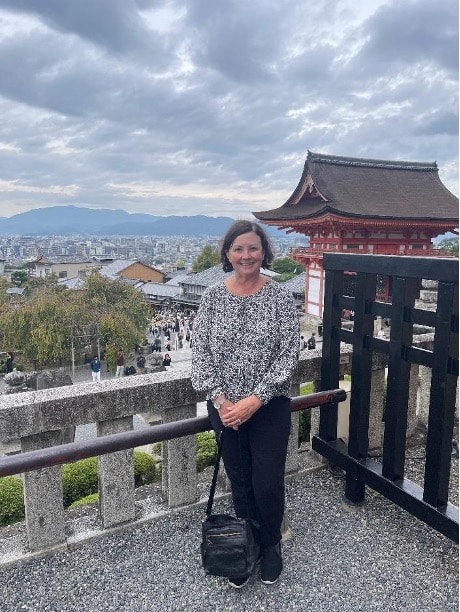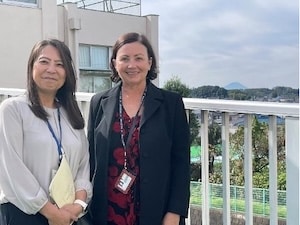LEADING LIGHTS Issue 1 | 2025

Postcard from Tokyo
From Bullet Trains to Classrooms: Insights on Education and Leadership in Tokyo
Postcards from around the world by Michele Morrison
October/November 2024

Michele Morrison With Yuriko Tokumasu, principal of Kotesashi Elementary School
Konnichiwa. Experiencing another education system firsthand, if only for a short while, offers important insights into another country and a different lens through which to reflect on school leadership in Aotearoa. As a visiting researcher at Waseda University, Tokyo, I’ve been fortunate to accompany colleagues, Tadashi Asada (Waseda University) and Seiji Ueda (Scared Heart University), to several elementary, junior high and senior high schools, where we’ve observed classes and met with school principals. Here’s what struck me most.
Unlike New Zealand’s highly devolved system, Japan’s governance structure is highly centralized. At the national level, the Ministry of Education, Culture, Sports, Science, and Technology (MEXT) oversees education provision from early childhood to tertiary. This includes national curriculum, teacher certification and remuneration, school accreditation, and the allocation of funding to 47 prefectures and over 1,700 local municipalities. At the prefecture or regional level, politically appointed education boards oversee the appointment and placement of teachers, and school evaluation. They also resource municipality education boards to conduct in-service professional development, select textbooks, and oversee the day-to-day operations of primary and junior high schools.
During my kōrero with principals, I learned that the central placement of teachers and principals in the public school system includes both location and tenure. Principals generally serve 1-3 years at any one school, and teachers for up to 6 years. In the Tokyo prefecture, teachers must serve in at least three different geographical areas during their first four placements. Deputy principals are appointed in a similar manner, with the incumbent principal having no voice in the appointment decision. Some latitude exists in that principals can appoint middle leaders within their schools; however, staff who have passed their vice-principal exams take priority regardless of suitability, and there is no guarantee that middle leaders can establish themselves in the role before being assigned to another school.
Minimal discretion over curriculum, staffing and budgeting must make educational innovation at the school level a challenging undertaking. As an outsider, I found myself pondering how ongoing staff rotation impacts school culture, relationships, and change processes. If, as research suggests, it takes five years to reculture a school and embed new initiatives, how do principals feel about not seeing fledging change efforts take flight? How do they manage resistance to pedagogical change in teachers who simply wait for them to depart? While conclusions based on single encounters are to be avoided, the principals I spoke with seemed system compliant. When I asked one whether they would like a voice in the appointment of staff, and the senior leadership team in particular, the ensuing silence suggested this was something they had never contemplated: “That’s the way things are”. Short appointment tenure appeared to generate both urgency and pragmatism in principals’ approaches to instructional leadership and academic press, with one devoting most of her time to mentoring the novice teachers she perceived central to the fast-tracking of pedagogical shift.
Brief exposure to the Japanese system got me thinking about the potential upsides, including the ability to place the ‘best’ teachers in schools where they’re needed most. In other words, a system emphasis on the collective, rather than individual schools. From a social justice perspective, the equity argument is an appealing one. PISA results show that not only do Japanese students perform consistently better than the OECD average in mathematics, reading and science, they do so across the socio-economic board. Of course, there’s much more to it than teacher performance alone. A heterogenous population (97.5% Japanese), the high value placed on education (over 98% attend post-compulsory education), tuition support for upper secondary school students whose families whose earnings fall below the annual income threshold, and recent government provision of digital technology for all students are all contributing factors. And, across all levels from primary to tertiary education, Japanese expenditure per full-time-equivalent (FTE) student exceeds the OECD average, while New Zealand’s fails to reach it (OECD, 2023).
Not that this investment was obvious in the physical infrastructure. Many of the schools I visited were multi-storeyed concrete buildings in which student artwork enlivened otherwise clinical surrounds. This served another reminder of how little power school leaders have over facilities and how meagre their discretionary funds are, the latter typically limited to parent association fundraising initiatives. I was not surprised to witness quiet, orderly and industrious classrooms, immaculately dressed students, and a fair bit of didactic teacher instruction. What stood out was the extent to which students are kaitiaki of their environment - serving lunch to their peers, clearing plates, and cleaning classrooms in a responsible and respectful manner. And I had to smile at the array of soft toys and anime figures clipped to regulation schoolbags. Not only did these accessories help students distinguish one bag from another; they also seemed reflective of a deeper need to express individual identity.
I quickly discovered that Japan’s reputation for efficiency is well-deserved and that a Kiwi Rail mindset doesn’t always serve you well. Knowing the latest the Shinkansen (bullet train) has ever departed is 20 seconds generated more than a little anxiety as I hurried through Kyoto Station on a return trip to Tokyo. A tight departure window saw me arrive at the correct platform out of breath and relieved to hear the evening train from Osaka was approaching rather than leaving the platform. So far, so good. I checked my ticket, boarded the designated carriage, walked down the aisle to the assigned seat, and was surprised to find it already occupied. Unable to speak more than a few words in Japanese, I went in search of assistance, by which time the doors had closed. It was then that I glanced at my watch – it simply hadn’t occurred to me that there might be more than one train leaving for Tokyo within 10 minutes and I was on the earlier one! Fortunately, a spare seat and understanding guard avoided me having to get off at the next station and wait my turn, an experience that provided yet another lesson in a month of fabulous leadership learning.
Sayōnaraさようなら

